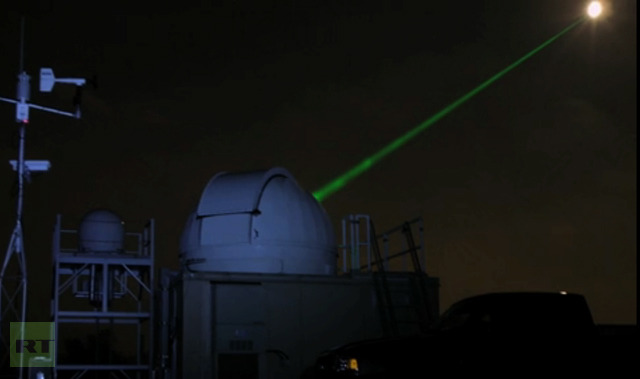It looks like you're using an Ad Blocker.
Please white-list or disable AboveTopSecret.com in your ad-blocking tool.
Thank you.
Some features of ATS will be disabled while you continue to use an ad-blocker.
2
share:
After all these years Mona Lisa continues to stay super busy, and she still looks great considering.
A new experiment by NASA, proving the effectiveness of laser communications, has raised the prospect that beam technology could one day replace radio.
Comparable to going from dial-up to fiber optic speeds.
That’s after NASA scientists successfully beamed an image of the Mona Lisa to the moon.
NASA usually uses lasers to track the position of the LRO, the spacecraft creating those gravitational maps of the moon, sending the info back to NASA at 50 mbs.
Then somebody sat up in bed one night and said, "Hey let's reverse the flow and beam an image... say, the Mona Lisa, to the moon"


Kidding of course.

In 2017 it plans to start a new experiment called Laser Communications Radar Demonstration – a commercial satellite that is going to test beam-based communication systems. The speed and volume of information that can the transferred by laser is an order of magnitude greater than the rates attainable with radio waves and will even rival, well....

Source
Letter and Number found in Mona Lisa
Hidden Animals in the Mona Lisa
Mona Lisa codes hoax?
Leonardo's Earlier Mona Lisa
Proof Mona Lisa an ET
A new experiment by NASA, proving the effectiveness of laser communications, has raised the prospect that beam technology could one day replace radio.
Comparable to going from dial-up to fiber optic speeds.
That’s after NASA scientists successfully beamed an image of the Mona Lisa to the moon.
NASA usually uses lasers to track the position of the LRO, the spacecraft creating those gravitational maps of the moon, sending the info back to NASA at 50 mbs.
Then somebody sat up in bed one night and said, "Hey let's reverse the flow and beam an image... say, the Mona Lisa, to the moon"

"This is the first time anyone has achieved one-way laser communication at planetary distances," says LOLA's principal investigator, David Smith of the Massachusetts Institute of Technology. "In the near future, this type of simple laser communication might serve as a backup for the radio communication that satellites use. In the more distant future, it may allow communication at higher data rates than present radio links can provide." The picture was transmitted to the LRO spacecraft, because it is the only satellite that has a laser receiver.
Precise timing is required to get the beam to hit such a tiny target so far away. The first attempt was not so successful:

Kidding of course.
The first attempt to reassemble the image was not successful, the quality of the picture was significantly degraded. Atmospheric turbulence and a slight pause in transmission caused errors, making the resulting image grainy, distorted and incomplete. The scientists then applied the same kind of data correction methods used for CDs and DVDs, which substantially helped clear up the image.

In 2017 it plans to start a new experiment called Laser Communications Radar Demonstration – a commercial satellite that is going to test beam-based communication systems. The speed and volume of information that can the transferred by laser is an order of magnitude greater than the rates attainable with radio waves and will even rival, well....

Source
Here are some other threads from recent ATS archives that are very interesting:
Letter and Number found in Mona Lisa
Hidden Animals in the Mona Lisa
Mona Lisa codes hoax?
Leonardo's Earlier Mona Lisa
Proof Mona Lisa an ET
edit on 1-2-2013 by Lonewulph because: (no reason given)
Sorry if you already posted the info, but Did you happen to see how long it took to get there and be received? It would be a good indicator of the
accuracy and usefullness of such a technology. To at least calculate if this could be used as interplanetary or intergalaxy comms. Obviously would
not be used for such for many years to come....since we have no-one to contact that far away. Or do we?
This is a great find OP
S&F for sharing this!!
This is a great find OP
S&F for sharing this!!
edit on 1-2-2013 by Teye22 because: (no reason given)
reply to post by Teye22
Thanks, the laser would travel at the speed of light, once on target the new experimental laser they hope will be capable of transmitting 600 million bits per second.... compared to a woafully slow data rate of 300 bits per second what is possible with cables or radio. Oh the possibilities just keep getting better.
Same source
Thanks, the laser would travel at the speed of light, once on target the new experimental laser they hope will be capable of transmitting 600 million bits per second.... compared to a woafully slow data rate of 300 bits per second what is possible with cables or radio. Oh the possibilities just keep getting better.
This is just one aspect of NASA’s planned research into laser communications. In 2017 it plans to start a new experiment called Laser Communications Radar Demonstration – a commercial satellite that is going to test beam-based communication systems.
Same source
edit on 1-2-2013 by Lonewulph because: (no reason given)
Isn't technology just...Wonderfull! It gets to a point when it's really hard to keep up with all the advancements.
Sending data at that rate is quite fast, and could open doors for further developments, who knows, they are still barely scratching the surface. Can't wait to see where this tech takes us in the future.
Sending data at that rate is quite fast, and could open doors for further developments, who knows, they are still barely scratching the surface. Can't wait to see where this tech takes us in the future.
Originally posted by Teye22
Sorry if you already posted the info, but Did you happen to see how long it took to get there and be received? It would be a good indicator of the accuracy and usefullness of such a technology. To at least calculate if this could be used as interplanetary or intergalaxy comms. Obviously would not be used for such for many years to come....since we have no-one to contact that far away. Or do we?
This is a great find OP
S&F for sharing this!!edit on 1-2-2013 by Teye22 because: (no reason given)
If the galaxy was 20 light years away, it would take 20 years for the data to get there. Just an FYI, radio waves move at the same speed as light. So this would not be any faster than sending radio waves to another galaxy.
Originally posted by Teye22
Isn't technology just...Wonderfull! It gets to a point when it's really hard to keep up with all the advancements.
Sending data at that rate is quite fast, and could open doors for further developments, who knows, they are still barely scratching the surface. Can't wait to see where this tech takes us in the future.
This is not 'fast'. Radio waves move at the speed of light. Same speed.
reply to post by OccamsRazor04
This is true as all waves travel at the speed of light, radio waves only have a lower freq.
This laser method may allow communication at higher data rates than present radio links can provide.
This is true as all waves travel at the speed of light, radio waves only have a lower freq.
This laser method may allow communication at higher data rates than present radio links can provide.
edit on 2-2-2013 by Lonewulph because: (no reason given)
They wasted their time sending a file to the moon with a laser.
Stream Porn to an undersea submarine. They've already used blue/green lasers to scan the ocean bottom proving lasers can be used through the ocean if it's the correct wavelength (blue/green).
Stream Porn to an undersea submarine. They've already used blue/green lasers to scan the ocean bottom proving lasers can be used through the ocean if it's the correct wavelength (blue/green).
new topics
-
SETI chief says US has no evidence for alien technology. 'And we never have'
Aliens and UFOs: 1 hours ago -
This is our Story
General Entertainment: 4 hours ago -
President BIDEN Vows to Make Americans Pay More Federal Taxes in 2025 - Political Suicide.
2024 Elections: 6 hours ago -
Ode to Artemis
General Chit Chat: 7 hours ago -
Ditching physical money
History: 10 hours ago -
One Flame Throwing Robot Dog for Christmas Please!
Weaponry: 10 hours ago -
Don't take advantage of people just because it seems easy it will backfire
Rant: 11 hours ago -
VirginOfGrand says hello
Introductions: 11 hours ago
top topics
-
University student disciplined after saying veganism is wrong and gender fluidity is stupid
Education and Media: 15 hours ago, 14 flags -
Police clash with St George’s Day protesters at central London rally
Social Issues and Civil Unrest: 17 hours ago, 10 flags -
President BIDEN Vows to Make Americans Pay More Federal Taxes in 2025 - Political Suicide.
2024 Elections: 6 hours ago, 10 flags -
Should Biden Replace Harris With AOC On the 2024 Democrat Ticket?
2024 Elections: 12 hours ago, 6 flags -
One Flame Throwing Robot Dog for Christmas Please!
Weaponry: 10 hours ago, 6 flags -
Ditching physical money
History: 10 hours ago, 4 flags -
Don't take advantage of people just because it seems easy it will backfire
Rant: 11 hours ago, 4 flags -
God lived as a Devil Dog.
Short Stories: 16 hours ago, 3 flags -
SETI chief says US has no evidence for alien technology. 'And we never have'
Aliens and UFOs: 1 hours ago, 3 flags -
VirginOfGrand says hello
Introductions: 11 hours ago, 2 flags
active topics
-
So this is what Hamas considers 'freedom fighting' ...
War On Terrorism • 227 • : HopeForTheFuture -
Remember These Attacks When President Trump 2.0 Retribution-Justice Commences.
2024 Elections • 51 • : Justoneman -
British TV Presenter Refuses To Use Guest's Preferred Pronouns
Education and Media • 131 • : FlyersFan -
Spectrophilia - Women Who Have Had Affairs With Ghosts Say Spooks Are Better Lovers Than Real Men
Paranormal Studies • 30 • : FlyersFan -
Breaking Baltimore, ship brings down bridge, mass casualties
Other Current Events • 471 • : bally001 -
-@TH3WH17ERABB17- -Q- ---TIME TO SHOW THE WORLD--- -Part- --44--
Dissecting Disinformation • 639 • : Justoneman -
University student disciplined after saying veganism is wrong and gender fluidity is stupid
Education and Media • 31 • : KrustyKrab -
SETI chief says US has no evidence for alien technology. 'And we never have'
Aliens and UFOs • 8 • : 19Bones79 -
Republican Voters Against Trump
2024 Elections • 289 • : Justoneman -
The Acronym Game .. Pt.3
General Chit Chat • 7742 • : bally001
2
